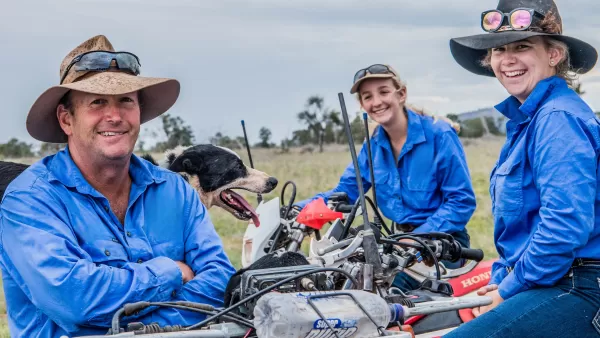Darling Downs Beef Cattle
Energy Savings: 31% | Cost Savings: $2,176 | Capital Cost: $6,390 | CO2 Savings: 7 | Project Status: implemented
Industry:
Beef
Location:
Maranoa-Balonne
Pump Type:
Bore, Diesel Pump
Irrigation Type:
Flood
Technology:
Solar Power and Renewables
An 11,000 ha beef farm in the Darling Downs region could benefit from a recent Energy Savers audit. Due to drought, the site is operating at reduced capacity although on average has approximately 2,000 head of cattle utilising 45 different paddocks. The site practices regenerative agriculture, a practice that has long-term effects towards a balanced ecosystem, which in turn helps increase yield and decrease pest outbreaks. In conjunction with energy efficiency, additional emissions can be sequestered should soil Carbon be increased using the practice.
From two years of data, the average energy consumption of the total farm was 27,766kWh at a cost of $3,467 per annum. A recent energy audit showed how improving the current systems can lead to energy and cost savings. The recommendations explored in the audit included:
- Installation of a 5.7kW Solar PV system at the house, where the cool rooms are located.
- Replace the bore pump with a more efficient unit.
- Replace the standalone diesel pump with an off-grid solar PV pump.
Table 1. Energy savings from audit recommendations
| Recommendation | Cost to Implement ($) | Energy Savings (kWh) | Cost Savings ($) | Payback Period (years) |
Emission Savings (tCO2-e) |
| 5.7kW Solar PV system | 6,390 | 8,603 | 2,176 | 2.9 | 7 |
| Bore Pump Replacement | 3,814 | 636 | 276 | 13.8 | 0.5 |
| Replace diesel pump with Solar PV system | 33,065 | 53,849 | 8,352 | 4 | 43.5 |
| Total | 43,269 | 63,088 | 10,804 | 6.9 | 51 |
The replacement of the bore pump has been designed using the measured Flow (m3/hr) and Head (m) as tested. As this pump has been sized using the measured flow and head, the result is a smaller motor size with greater efficiency. A variable speed drive (VSD) was not suitable in this case as Submersible pumps require longer cable lengths. In that case, a sine filter would be required to reduce the rate of voltage change. Network distortion can also be a problem and to avoid this you would need a low harmonic VSD, which is more expensive. It is generally simpler to look for total pump replacement when looking at reducing energy consumption on a submersible pump.
The specification of the diesel motor shows a fuel consumption of 1.88L/hr when operating at 100% and the cost of operation at $1.50/L. Based on current operational figures a significant saving of 53,849kWh and $8,352 in operating costs could be achieved.
The farmer proceeded with the implementation of the 5.7 kW solar PV system onto the house, with potential energy consumption savings of 31%, costs savings of 63%, and carbon emission savings of 7 tCO2-e per year. Actual savings will be updated once the measurement and verification process is complete.
Table 2. Pre and post audit energy consumption, costs, and energy productivity savings
| Metric | Pre-Audit | Post-Audit | Reduction (%) |
| Energy Consumption (kWh) | 27,766 | 19,163 | 31 |
| Cost ($) | 3,467 | 1,291 | 63 |
| Energy Productivity (kWh/ha) | 2.5 | 1.7 | 31 |
An energy audit is a good investment
An energy audit is a great first step in moving a business towards a more efficient future by reducing energy use, costs, and Carbon emissions onsite.
The Energy Savers Plus Extension Program was delivered by the Queensland Farmers' Federation with support and funding from the Queensland Department of Energy and Public Works.

